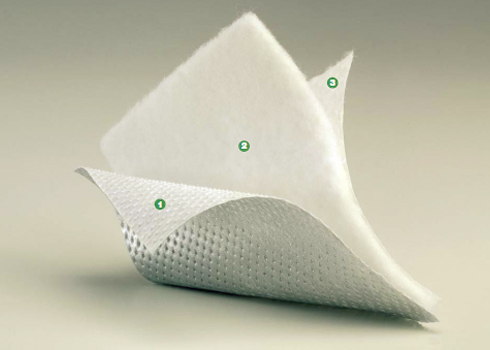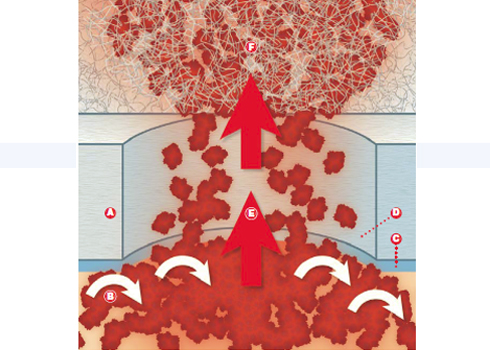The matte overlay on Metalline dressings is a very thin, soft, aluminized nonwoven with good drainage. The smooth surface does not adhere to wounds. This means the wound is undisturbed and dressing changes are atraumatic, which has a positive effect on the course of healing.

Metalline is made up of multiple layers
1. The wound side
Metalline’s wound-contact layer is composed of a perforated viscose nonwoven material which is especially suitable for medical purposes. The individual fibres are coated with aluminium using a high-vacuum vaporization process. This creates a porous, non-adherent layer with a shiny, very smooth surface onto which wound exudate cannot adhere. As a result, Metalline does not adhere to wounds. This aluminium-coated Metalline layer is not itself absorbent and is not affected by water, blood or secretions.
2. The absorbent layer
Because Metalline’s aluminium-coated layer is highly porous the exudate diffuses into the absorbent layer, which very rapidly absorbs and retains blood and exudate. Draining blood is absorbed immediately and transported rapidly into the absorbent nonwoven layer by the capillary action of the Metalline pores. This has almost no wetting effect on Metalline’s surface. The pores also ensure an unrestricted supply of air to the wound.
3. The top layer
The top layer, which is made from a thin nonwoven material, covers the absorbent layer.

Side view, cross-section illustration of Metalline.
How Metalline works:
- A) the nonwoven, aluminium-coated, non-adherent wound-contact layer
- B) exudate cannot adhere to the smooth surface
- C) a thin film of fluid on the surface
- D) the pores through which the ...
- E) ... excessive exudate drains into the ...
- F) ... absorbent layer above it where it is absorbed and retained
